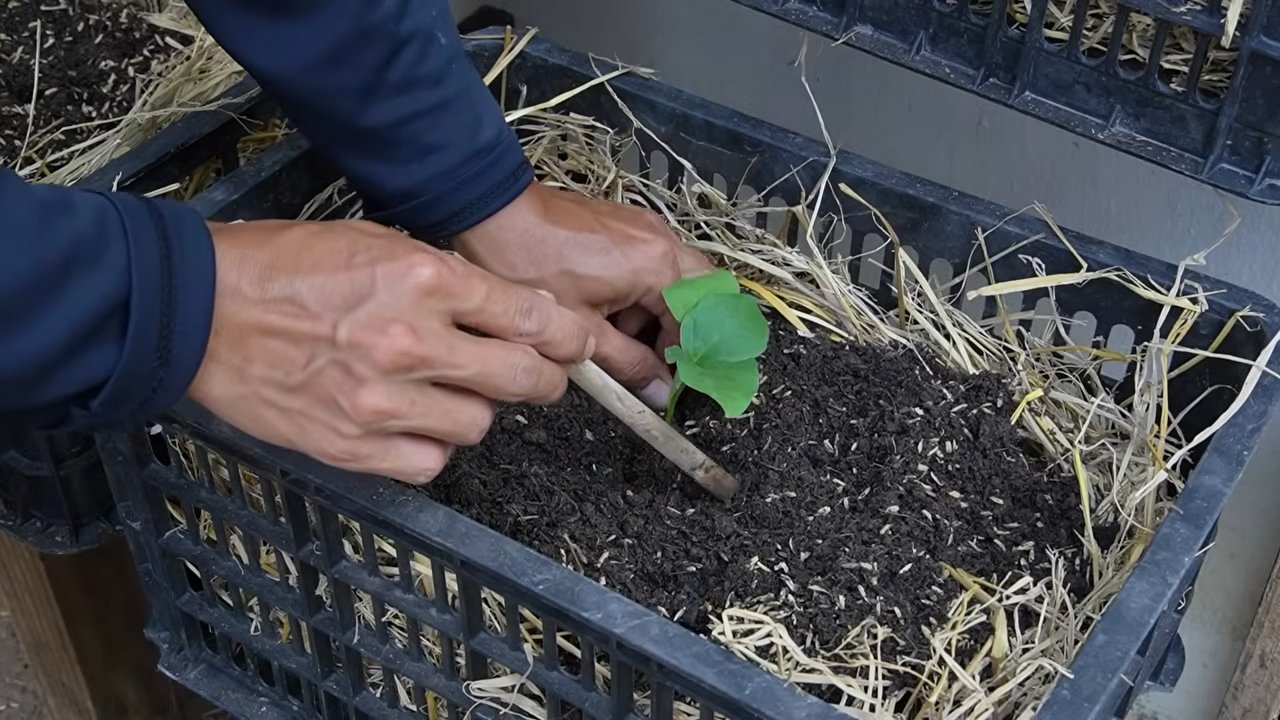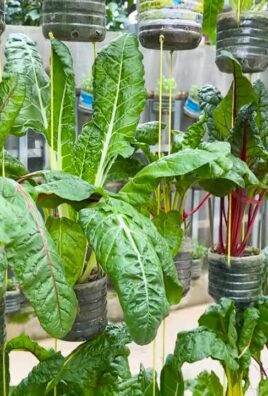Growing Eggplants at Home can seem daunting, but trust me, with a few simple tricks and a little DIY spirit, you can be harvesting your own delicious, glossy eggplants in no time! Imagine serving up a homemade eggplant parmesan, knowing you nurtured those beauties from tiny seedlings. Sounds rewarding, right?
Eggplants, also known as aubergines, have a rich history, originating in India and making their way across the globe. They’ve been cultivated for centuries, holding a special place in cuisines from the Mediterranean to Asia. Think of moussaka in Greece or eggplant curry in India – these dishes wouldn’t be the same without this versatile vegetable.
But why bother with the effort of growing your own? Well, store-bought eggplants often lack the vibrant flavor and freshness of homegrown ones. Plus, you have complete control over the growing process, ensuring they’re free from harmful pesticides. More importantly, growing eggplants at home is incredibly satisfying! This DIY guide will equip you with the knowledge to overcome common challenges, like pest control and proper watering, and unlock the secrets to a bountiful harvest. So, let’s get our hands dirty and transform your garden into an eggplant paradise!

Auberginen selbst anbauen: Dein umfassender DIY-Leitfaden
Hallo Gartenfreunde! Ich liebe Auberginen, und es gibt nichts Besseres, als sie frisch aus dem eigenen Garten zu ernten. Sie schmecken einfach intensiver und sind so vielseitig in der Küche einsetzbar. Deshalb möchte ich euch heute zeigen, wie ihr ganz einfach eure eigenen Auberginen zu Hause anbauen könnt. Keine Angst, es ist gar nicht so schwer, wie es vielleicht klingt!
Was du für den Auberginenanbau brauchst
Bevor wir loslegen, hier eine Liste mit allem, was du benötigst:
* Auberginensamen oder Jungpflanzen: Du kannst entweder mit Samen starten oder dir bereits vorgezogene Jungpflanzen kaufen. Ich persönlich finde es spannend, mit Samen anzufangen, aber Jungpflanzen sind natürlich schneller und einfacher.
* Anzuchttöpfe oder -schalen: Wenn du mit Samen startest, brauchst du kleine Töpfe oder Schalen für die Anzucht.
* Anzuchterde: Diese Erde ist besonders nährstoffarm und locker, ideal für die Keimung der Samen.
* Pflanztöpfe (für größere Pflanzen) oder ein Gartenbeet: Auberginen brauchen Platz zum Wachsen.
* Gartenerde: Eine gute, nährstoffreiche Gartenerde ist wichtig für das Wachstum der Pflanzen.
* Kompost oder organischer Dünger: Auberginen sind Starkzehrer und brauchen ausreichend Nährstoffe.
* Pflanzstäbe oder Rankgitter: Einige Auberginensorten werden sehr hoch und brauchen Unterstützung.
* Gießkanne oder Gartenschlauch: Regelmäßiges Gießen ist unerlässlich.
* Gartenschere: Zum Ausgeizen und Ernten.
* (Optional) Gewächshaus oder Folientunnel: In kühleren Regionen kann ein Gewächshaus oder Folientunnel helfen, die Auberginen vor Kälte zu schützen.
Aussaat und Anzucht (wenn du mit Samen startest)
Wenn du dich für den Anbau aus Samen entschieden hast, ist hier eine detaillierte Anleitung:
1. Der richtige Zeitpunkt: Beginne mit der Aussaat im Haus etwa 8-10 Wochen vor dem letzten erwarteten Frost. Das ist meistens im Februar oder März.
2. Die Vorbereitung: Fülle deine Anzuchttöpfe oder -schalen mit Anzuchterde. Drücke die Erde leicht an.
3. Die Aussaat: Lege 2-3 Samen pro Topf etwa 0,5-1 cm tief in die Erde. Bedecke die Samen leicht mit Erde und gieße sie vorsichtig an.
4. Die Keimung: Stelle die Töpfe an einen warmen und hellen Ort. Eine Temperatur von 22-25°C ist ideal. Du kannst auch eine Heizmatte verwenden, um die Keimung zu beschleunigen. Halte die Erde feucht, aber nicht nass.
5. Das Pikieren: Sobald die Sämlinge ihre ersten richtigen Blätter (neben den Keimblättern) entwickelt haben, kannst du sie pikieren. Das bedeutet, du setzt jeden Sämling einzeln in einen größeren Topf um. Wähle dafür einen Topf mit etwa 8-10 cm Durchmesser und verwende normale Blumenerde.
6. Die Pflege: Stelle die pikierten Sämlinge an einen hellen Ort und gieße sie regelmäßig. Dünge sie alle zwei Wochen mit einem milden Flüssigdünger.
Die Vorbereitung des Pflanzortes
Egal, ob du Jungpflanzen gekauft oder selbst vorgezogen hast, die Vorbereitung des Pflanzortes ist entscheidend:
1. Der richtige Standort: Auberginen lieben die Sonne! Wähle einen sonnigen und windgeschützten Standort für deine Pflanzen. Mindestens 6-8 Stunden Sonne pro Tag sind ideal.
2. Der Boden: Auberginen bevorzugen einen lockeren, gut durchlässigen und nährstoffreichen Boden. Verbessere den Boden, indem du Kompost oder organischen Dünger einarbeitest.
3. Die Vorbereitung des Beetes: Grabe das Beet um und entferne Unkraut und Steine. Lockere den Boden gut auf.
4. Die Vorbereitung der Töpfe: Wenn du Auberginen in Töpfen anbaust, wähle Töpfe mit einem Durchmesser von mindestens 30 cm. Fülle die Töpfe mit guter Gartenerde und mische Kompost oder organischen Dünger unter.
Das Auspflanzen der Auberginen
Jetzt kommt der spannende Teil: das Auspflanzen!
1. Der richtige Zeitpunkt: Warte, bis keine Frostgefahr mehr besteht, bevor du die Auberginen auspflanzt. Das ist meistens Mitte Mai.
2. Die Abhärtung: Bevor du die Pflanzen auspflanzt, solltest du sie einige Tage lang abhärten. Stelle sie tagsüber ins Freie und hole sie nachts wieder herein. So gewöhnen sie sich langsam an die Bedingungen im Freien.
3. Das Auspflanzen: Grabe Löcher, die etwas größer sind als die Wurzelballen der Pflanzen. Setze die Pflanzen vorsichtig in die Löcher und fülle sie mit Erde auf. Drücke die Erde leicht an und gieße die Pflanzen gut an.
4. Der Abstand: Achte auf einen ausreichenden Abstand zwischen den Pflanzen. Etwa 45-60 cm zwischen den Pflanzen und 75-90 cm zwischen den Reihen sind ideal.
5. Die Unterstützung: Stecke Pflanzstäbe oder Rankgitter neben die Pflanzen, um sie zu unterstützen. Auberginen können sehr hoch werden und brauchen Halt.
Die Pflege der Auberginenpflanzen
Die Pflege ist entscheidend für eine reiche Ernte:
1. Das Gießen: Gieße die Auberginen regelmäßig, besonders bei trockenem Wetter. Achte darauf, dass die Erde immer feucht ist, aber nicht nass. Vermeide es, die Blätter zu gießen, um Pilzkrankheiten vorzubeugen.
2. Das Düngen: Auberginen sind Starkzehrer und brauchen regelmäßig Dünger. Dünge sie alle zwei Wochen mit einem organischen Dünger oder Komposttee.
3. Das Ausgeizen: Entferne regelmäßig die Seitentriebe, die zwischen dem Haupttrieb und den Blättern wachsen. Das Ausgeizen fördert das Wachstum der Früchte und verhindert, dass die Pflanze zu buschig wird.
4. Die Schädlingsbekämpfung: Auberginen können von verschiedenen Schädlingen befallen werden, wie z.B. Blattläusen, Spinnmilben oder Kartoffelkäfern. Kontrolliere die Pflanzen regelmäßig und bekämpfe Schädlinge bei Bedarf mit natürlichen Mitteln, wie z.B. Neemöl oder Schmierseifenlösung.
5. Das Mulchen: Mulche den Boden um die Pflanzen mit Stroh oder Rasenschnitt. Das Mulchen hält den Boden feucht, unterdrückt Unkraut und schützt die Pflanzen vor Bodenspritzern.
Die Ernte der Auberginen
Endlich ist es soweit: die Ernte!
1. Der richtige Zeitpunkt: Auberginen sind erntereif, wenn sie eine glänzende, pralle Haut haben und sich leicht eindrücken lassen. Die Farbe sollte intensiv sein.
2. Die Ernte: Schneide die Auberginen mit einer Gartenschere ab. Lasse einen kleinen Stiel an der Frucht.
3. Die Lagerung: Auberginen sind nicht lange haltbar. Lagere sie im Kühlschrank und verbrauche sie innerhalb weniger Tage.
Häufige Probleme und Lösungen
Auch beim Auberginenanbau können Probleme auftreten. Hier sind einige häufige Probleme und ihre Lösungen:
* Blütenfall: Wenn die Blüten abfallen, ohne Früchte zu bilden, kann das verschiedene Ursachen haben, wie z.B. zu hohe oder zu niedrige Temperaturen, Wassermangel oder Nährstoffmangel. Sorge für optimale Bedingungen und dünge die Pflanzen regelmäßig.
* Gelbe Blätter: Gelbe Blätter können auf Nährstoffmangel, Wassermangel oder Schädlingsbefall hindeuten. Überprüfe die Bedingungen und dünge die Pflanzen bei Bedarf.
* Pilzkrankheiten: Pilzkrankheiten, wie z.B. Mehltau oder Grauschimmel, können bei feuchtem Wetter auftreten. Sorge für eine gute Belüftung und vermeide es, die Blätter zu gießen. Bei Bedarf kannst du ein Fung

Conclusion
So, there you have it! Growing eggplants at home, while it might seem daunting at first, is an incredibly rewarding experience that brings the vibrant flavors of summer right to your kitchen. We’ve explored the key steps, from selecting the right variety and starting seeds indoors to transplanting, providing essential care, and finally, harvesting those beautiful, glossy fruits. But why is this DIY approach a must-try?
Firstly, the taste difference is undeniable. Store-bought eggplants often lack the depth of flavor and tenderness that homegrown varieties possess. When you nurture your own plants, you control every aspect of their environment, resulting in eggplants that are bursting with freshness and character. Imagine the satisfaction of serving a dish made with eggplants you personally cultivated – the compliments will be endless!
Secondly, growing your own eggplants is a sustainable and cost-effective choice. You’ll reduce your reliance on commercially grown produce, which often involves long-distance transportation and potentially harmful pesticides. Plus, once you have your initial setup, the cost of growing your own eggplants is significantly lower than buying them regularly from the store.
Thirdly, it’s a fantastic learning experience. Gardening is a therapeutic activity that connects you with nature and teaches you valuable skills. You’ll gain a deeper understanding of plant life cycles, soil health, and the importance of sustainable practices. It’s a hobby that can be enjoyed by people of all ages and skill levels.
But the journey doesn’t end here! Feel free to experiment with different eggplant varieties to discover your favorites. Try growing classic Italian eggplants, slender Japanese eggplants, or even the unique Thai green eggplants. You can also explore different growing methods, such as container gardening or raised beds, to suit your space and preferences. Consider companion planting with herbs like basil or thyme to deter pests and enhance the flavor of your eggplants.
Don’t be afraid to get creative and adapt these techniques to your specific climate and growing conditions. Remember to observe your plants closely, paying attention to their needs and adjusting your care accordingly.
We wholeheartedly encourage you to embark on this exciting adventure of growing eggplants at home. It’s a journey filled with challenges, rewards, and, most importantly, delicious eggplants! Once you’ve harvested your first crop, we’d love to hear about your experience. Share your tips, successes, and even your struggles in the comments below. Let’s create a community of eggplant enthusiasts who are passionate about growing their own food. Happy gardening!
Frequently Asked Questions (FAQ)
1. What are the best eggplant varieties to grow at home?
The best eggplant variety depends on your climate, growing space, and personal preferences. For beginners, classic Italian eggplants like ‘Black Beauty’ are a great choice due to their reliability and ease of growth. If you have limited space, consider compact varieties like ‘Patio Baby’ or ‘Fairy Tale.’ For warmer climates, Japanese eggplants like ‘Ichiban’ or ‘Long Purple’ are excellent options. Experimenting with different varieties is part of the fun! Consider your local climate and growing season when making your selection. Look for varieties that are disease-resistant and well-suited to your region.
2. How do I start eggplant seeds indoors?
Starting eggplant seeds indoors is crucial for getting a head start on the growing season, especially in cooler climates. Start seeds 6-8 weeks before the last expected frost. Use a seed-starting mix and sow seeds about ¼ inch deep in individual pots or seed trays. Keep the soil consistently moist but not waterlogged. Eggplants need warm temperatures to germinate, ideally between 75-85°F (24-29°C). Use a heat mat to maintain consistent warmth. Once seedlings emerge, provide them with plenty of light, either from a sunny window or a grow light. Harden off the seedlings gradually before transplanting them outdoors.
3. When and how do I transplant eggplant seedlings outdoors?
Transplant eggplant seedlings outdoors after the last frost when the soil has warmed up to at least 60°F (15°C). Choose a sunny location with well-drained soil. Space plants about 2-3 feet apart to allow for adequate air circulation. Dig a hole slightly larger than the root ball and gently remove the seedling from its container. Place the seedling in the hole and backfill with soil, gently firming it around the base of the plant. Water thoroughly after transplanting. Consider adding a layer of mulch around the plants to help retain moisture and suppress weeds.
4. What are the common pests and diseases that affect eggplants, and how can I prevent them?
Eggplants are susceptible to several pests and diseases, including aphids, flea beetles, spider mites, and verticillium wilt. To prevent pest infestations, inspect your plants regularly and remove any pests by hand or with a strong spray of water. Use insecticidal soap or neem oil as a natural pest control option. To prevent diseases, ensure good air circulation around your plants and avoid overwatering. Choose disease-resistant varieties whenever possible. Practice crop rotation to prevent soilborne diseases from building up.
5. How often should I water and fertilize my eggplants?
Eggplants need consistent moisture, especially during hot weather. Water deeply whenever the top inch of soil feels dry. Avoid overhead watering, as this can promote fungal diseases. Fertilize eggplants regularly with a balanced fertilizer, following the instructions on the package. You can also amend the soil with compost or aged manure to provide essential nutrients. Avoid over-fertilizing, as this can lead to excessive foliage growth and reduced fruit production.
6. How do I know when my eggplants are ready to harvest?
Eggplants are typically ready to harvest when they are glossy, firm, and have reached their mature size. The skin should be smooth and unblemished. Gently press the skin with your thumb; if it leaves a slight indentation, the eggplant is ripe. Use a sharp knife or pruning shears to cut the eggplant from the plant, leaving a short stem attached. Harvest eggplants regularly to encourage continued fruit production.
7. Can I grow eggplants in containers?
Yes, eggplants can be successfully grown in containers, making them a great option for gardeners with limited space. Choose a large container, at least 12 inches in diameter, with drainage holes. Use a high-quality potting mix and provide regular watering and fertilization. Container-grown eggplants may need to be watered more frequently than those grown in the ground, especially during hot weather.
8. What are some creative ways to use my homegrown eggplants?
The possibilities are endless! You can grill, bake, roast, or fry eggplants. Use them in classic dishes like eggplant parmesan, baba ghanoush, or ratatouille. Add them to stir-fries, curries, or pasta sauces. You can even pickle or ferment eggplants for a unique and flavorful treat. Don’t be afraid to experiment and discover your own favorite eggplant recipes!
9. How can I improve the flavor of my homegrown eggplants?
Several factors can influence the flavor of your homegrown eggplants. Choose high-quality seeds or seedlings from a reputable source. Provide your plants with optimal growing conditions, including plenty of sunlight, well-drained soil, and consistent watering. Harvest eggplants when they are fully ripe but not overripe. Consider salting eggplant slices before cooking to draw out excess moisture and reduce bitterness.
10. What if my eggplant plant is producing flowers but no fruit?
This can be frustrating, but there are several possible reasons why your eggplant plant might not be producing fruit. Insufficient pollination is a common cause. Eggplants are self-pollinating, but they may need help from wind or insects to transfer pollen. You can try hand-pollinating the flowers by gently shaking the plant or using a small brush to transfer pollen from one flower to another. Other factors that can affect fruit set include high temperatures, lack of water, and nutrient deficiencies. Ensure that your plants are receiving adequate care and adjust your growing conditions as needed.





Leave a Comment